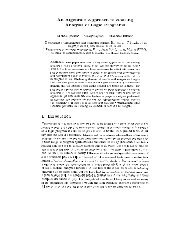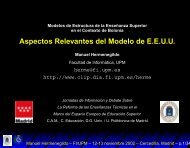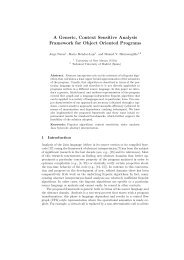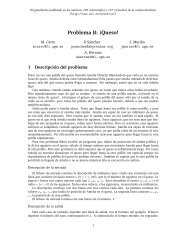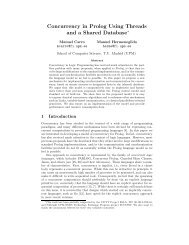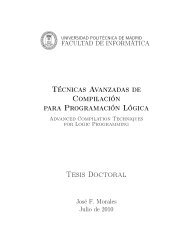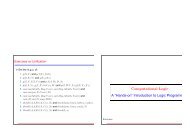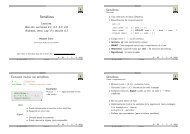Verified Resource Guarantees using COSTA and KeY
Verified Resource Guarantees using COSTA and KeY
Verified Resource Guarantees using COSTA and KeY
You also want an ePaper? Increase the reach of your titles
YUMPU automatically turns print PDFs into web optimized ePapers that Google loves.
<strong>Verified</strong> <strong>Resource</strong> <strong>Guarantees</strong> <strong>using</strong> <strong>COSTA</strong> <strong>and</strong> <strong>KeY</strong><br />
Elvira Albert<br />
Complutense University of Madrid<br />
elvira@sip.ucm.es<br />
Richard Bubel<br />
Chalmers University of Technology<br />
bubel@chalmers.se<br />
Samir Genaim<br />
Complutense University of Madrid<br />
samir.genaim@fdi.ucm.es<br />
Reiner Hähnle<br />
Chalmers University of Technology<br />
reiner@chalmers.se<br />
Germán Puebla<br />
Technical University of Madrid<br />
german@fi.upm.es<br />
Guillermo Román-Díez<br />
Technical University of Madrid<br />
groman@fi.upm.es<br />
Abstract<br />
<strong>Resource</strong> guarantees allow being certain that programs will run<br />
within the indicated amount of resources, which may refer to memory<br />
consumption, number of instructions executed, etc. This information<br />
can be very useful, especially in real-time <strong>and</strong> safety-critical<br />
applications. Nowadays, a number of automatic tools exist, often<br />
based on type systems or static analysis, which produce such resource<br />
guarantees. In spite of being based on theoretically sound<br />
techniques, the implemented tools may contain bugs which render<br />
the resource guarantees thus obtained not completely trustworthy.<br />
Performing full-blown verification of such tools is a daunting task,<br />
since they are large <strong>and</strong> complex. In this work we investigate an alternative<br />
approach whereby, instead of the tools, we formally verify<br />
the results of the tools. We have implemented this idea <strong>using</strong><br />
<strong>COSTA</strong>, a state-of-the-art static analysis system, for producing resource<br />
guarantees <strong>and</strong> <strong>KeY</strong>, a state-of-the-art verification tool, for<br />
formally verifying the correctness of such resource guarantees. Our<br />
preliminary results show that the proposed tool cooperation can be<br />
used for automatically producing verified resource guarantees.<br />
Categories <strong>and</strong> Subject Descriptors F3.2 [Logics <strong>and</strong> Meaning<br />
of Programs]: Program Analysis; F2.9 [Analysis of Algorithms<br />
<strong>and</strong> Problem Complexity]; D3.0 [Programming Languages]<br />
General Terms<br />
Keywords<br />
1. Introduction<br />
Languages, Theory, Verification, Reliability<br />
Static Analysis, <strong>Resource</strong> <strong>Guarantees</strong>, Java<br />
There is a growing awareness, both in industry <strong>and</strong> academia, of the<br />
crucial role of formally proving the correctness of systems. Verifying<br />
the correctness of modern static analyzers is rather challenging,<br />
among other things, because of the sophisticated algorithms used in<br />
them, their evolution over time, <strong>and</strong>, possibly, proprietary considerations.<br />
A simpler alternative is to construct a validating tool [7]<br />
which, after every run of the analyzer, formally confirms that the results<br />
are correct <strong>and</strong>, optionally, generates correctness proofs. Such<br />
proofs could then be translated to resource certificates [5, 6].<br />
Permission to make digital or hard copies of all or part of this work for personal or<br />
classroom use is granted without fee provided that copies are not made or distributed<br />
for profit or commercial advantage <strong>and</strong> that copies bear this notice <strong>and</strong> the full citation<br />
on the first page. To copy otherwise, to republish, to post on servers or to redistribute<br />
to lists, requires prior specific permission <strong>and</strong>/or a fee.<br />
PEPM’11, January 24–25, 2011, Austin, Texas, USA.<br />
Copyright c○ 2011 ACM 978-1-4503-0485-6/11/01. . . $10.00<br />
In this work, we are interested in resource guarantees obtained<br />
by static analysis. An essential aspect of programs is that resources<br />
be used effectively. This is especially true in the current programming<br />
trends, which provide us with mechanisms for code reuse by<br />
means of components <strong>and</strong> services: not only functionality, but also<br />
resource consumption (or cost) must be taken into consideration.<br />
<strong>COSTA</strong> is a state-of-the-art COSt <strong>and</strong> Termination Analyzer for<br />
Java bytecode (<strong>and</strong> hence Java). It receives as input the bytecode<br />
of a Java program, the signature of the method whose cost is to<br />
be inferred, a choice of one among several available cost models<br />
(termination [1], number of bytecode instructions [3], memory<br />
consumption, or calls to certain method) <strong>and</strong> automatically infers<br />
an upper bound (UB for short) on the cost as a function of the<br />
method’s input arguments. The most challenging step is to infer<br />
UBs for the loops in the program [2]. Intuitively, this requires<br />
(1) bounding the number of iterations of each loop <strong>and</strong> (2) finding<br />
the worst-case cost among all iterations. Ranking functions [8] give<br />
us safe approximations for requirement (1). To infer the maximal<br />
cost in requirement (2), we need to track how the values of variables<br />
change in the loop iterations <strong>and</strong> the inter-relations between (the<br />
values of) variables. As we will see, this information is obtained in<br />
<strong>COSTA</strong> by means of loop invariants <strong>and</strong> size relations. The analysis<br />
algorithms used in <strong>COSTA</strong> for inferring the main components of the<br />
UB generation were proven correct at a theoretical level. However,<br />
there is no guarantee that correctness is preserved in the actual<br />
implementation which is rather involved.<br />
<strong>KeY</strong> [4] is a state-of-the-art source code verification tool for the<br />
Java programming language. Its coverage of Java is comparable to<br />
that of <strong>COSTA</strong> (nearly full sequential Java, plus a simplified concurrency<br />
model). <strong>KeY</strong> implements a logic-based setting of symbolic<br />
execution that allows deep integration with aggressive first-order<br />
simplification. While the degree of automation of <strong>KeY</strong> is very high<br />
on loop- <strong>and</strong> recursion-free programs, the user must in general supply<br />
suitable invariants to deal with loops <strong>and</strong> recursion. In general,<br />
invariants that are sufficient to prove complex functional properties<br />
cannot be inferred automatically. However, simpler invariants<br />
that are sufficient to establish UBs can be automatically derived in<br />
many cases <strong>and</strong> this is exactly <strong>COSTA</strong>’s forte. Our work is based on<br />
the insight that the static analysis tool <strong>COSTA</strong> <strong>and</strong> the formal verification<br />
tool <strong>KeY</strong> have complementary strengths: <strong>COSTA</strong> is able to<br />
derive UBs of Java programs including the invariants needed to obtain<br />
them. This information is enough for <strong>KeY</strong> to prove the validity<br />
of the bounds <strong>and</strong> provide a certificate. The main contribution of<br />
this work is to show that, <strong>using</strong> <strong>KeY</strong>, it is possible to formally <strong>and</strong><br />
automatically verify the correctness of the UBs obtained by <strong>COSTA</strong>.
2. Inference of Upper Bounds in <strong>COSTA</strong><br />
In this section, we briefly describe the techniques used in <strong>COSTA</strong> for<br />
automatically inferring UBs, <strong>and</strong> we identify the proof obligations<br />
that need to be verified <strong>using</strong> <strong>KeY</strong>.<br />
2.1 Main Components of an Upper Bound<br />
Consider the following (JML annotated) program that implements<br />
the insert sort algorithm.<br />
1void insert sort (int A[]) {<br />
2 int i , j , v;<br />
3 //@ ghost int i 0 =i; int j 0 =j; int a 0 =a;<br />
4 i =A.length−2;<br />
5 //@ assert (i=i 0 −2 ∧ j=j 0 ∧ a=a 0 )<br />
6 //@ ghost int i 1 =i; int j 1 =j; int a 1 =a;<br />
7 //@ loop invariant i≤i 1<br />
8 //@ decreases i>0 ? i : 0<br />
9 while ( i >=0 ) {<br />
10 //@ ghost int i 2 =i; int j 2 =j; int a 2 =a;<br />
11 j =i+1;<br />
12 v=A[i];<br />
13 //@ assert j=i 2 +1 ∧ i 2 ≥ 0<br />
14 //@ ghost int i 3 =i; int j 3 =j; int a 3 =a;<br />
15 //@ loop invariant j≤a 3<br />
16 //@ decreases a − j>0 ? a − j : 0<br />
17 while ( j
for this invariant consists of one line defining all ¯w as ghost variables<br />
(“//@ ghost int w 1 = v 1 ;. . .; int w n = v n”) <strong>and</strong> one line for<br />
declaring the loop invariant (“//@ loop invariant ϕ”).<br />
Size relations. Size relations are linear constraints between the<br />
values of a set of variables of interest between two program points.<br />
As we have seen, this allows composing the cost of the different<br />
program fragments. For each loop (or method call), <strong>COSTA</strong> infers<br />
the relation ϕ between the values before the loop entry (or the<br />
call) <strong>and</strong> the entry of its parent scope. Suppose that the loop (or<br />
the call) is at line L l , its parent scope starts at line L p, <strong>and</strong> that ¯v<br />
are the variables of interest at L l <strong>and</strong> ¯w represent their values at<br />
L p. Then we add the JML annotation “//@ ghost int w 1 = v 1 ;. . .<br />
; int w n = v n;” immediately after line L p to capture the values of<br />
¯v at line L p, <strong>and</strong> the JML annotation “//@ assert ϕ” immediately<br />
before line L l to state that the relation ϕ must hold at the program<br />
point. Additional size relations inferred by <strong>COSTA</strong> are input-output<br />
size relations. These are linear constraints that relate the return<br />
value of a given method to its input values. For example, suppose<br />
that we replace “i −−” in line 21 of the insert sort program by “i<br />
=decrement(i)” where decrement is defined by “int decrement(int<br />
x) {return x−1;}”. Then <strong>COSTA</strong> infers the relation “ϕ ≡\result=<br />
x−1” which is used to bound the number of iterations of that loop.<br />
In order to verify this relation in <strong>KeY</strong> we add the JML annotation<br />
“//@ ensures ϕ” to the contract of decrement.<br />
3. Verification of Upper Bounds <strong>using</strong> <strong>KeY</strong><br />
We now describe the verification techniques used in <strong>KeY</strong> to prove<br />
program correctness, foc<strong>using</strong> on those relevant to UB verification.<br />
3.1 Verification by Symbolic Execution<br />
The program logic used by <strong>KeY</strong> is JavaCard Dynamic Logic<br />
(JavaDL) [4], a first-order dynamic logic with arithmetic. Programs<br />
are first-class citizens similar to Hoare logics but, in dynamic<br />
logic, correctness assertions can appear arbitrarily nested. JavaDL<br />
extends sorted first-order logic by a program modality 〈·〉· (read<br />
“diamond”). Let p denote a sequence of executable Java statements<br />
<strong>and</strong> φ an arbitrary JavaDL formula, then 〈p〉φ is a JavaDL formula<br />
which states that program p terminates <strong>and</strong> in its final state φ holds.<br />
A typical formula in JavaDL looks like<br />
.<br />
i = i0 ∧ j = . { }} {<br />
.<br />
j0 −> 〈 i=j-i;j=j-i;i=i+j;〉(i = j0 ∧ j = . i0)<br />
where i, j are program variables represented as non-rigid constants.<br />
Non-rigid constants <strong>and</strong> functions are state-dependent: their value<br />
can be changed by programs. The rigid constants i0, j0 are stateindependent:<br />
their value cannot be changed. The formula above<br />
says that if program p is executed in a state where i <strong>and</strong> j have<br />
values i0, j0, then p terminates <strong>and</strong> in its final state the values<br />
of the variables are swapped. To reason about JavaDL formulas,<br />
<strong>KeY</strong> employs a sequent calculus whose rules perform symbolic<br />
execution of the programs in the modalities. Here is a typical rule:<br />
ifSplit<br />
p<br />
Γ, b =⇒ 〈{p}rest〉φ, ∆ Γ, ¬b =⇒ 〈{q}rest〉φ, ∆<br />
Γ =⇒ 〈if (b) {p} else {q} rest〉φ, ∆<br />
As values are symbolic, it is in general necessary to split the proof<br />
whenever an implicit or explicit case distinction is executed. It<br />
is also necessary to represent the symbolic values of variables<br />
throughout execution. This becomes apparent when statements<br />
with side effects are executed, notably assignments. The assignment<br />
rule in JavaDL looks as follows:<br />
assign<br />
Γ =⇒ {x := val}〈rest〉φ, ∆<br />
Γ =⇒ 〈x = val; rest〉φ, ∆<br />
The expression in curly braces in the premise is called update <strong>and</strong><br />
is used in <strong>KeY</strong> to represent symbolic state changes. An elementary<br />
update loc := val is a pair of a location (program variable, field,<br />
array) <strong>and</strong> a value. The meaning of updates is the same as that of an<br />
assignment, but they can be composed in different ways to represent<br />
complex state changes. Updates u 1, u 2 can be composed into<br />
parallel updates u 1‖u 2. In case of clashes (updates u 1, u 2 assign<br />
different values to the same location) a last-wins semantics resolves<br />
the conflict. This reflects left-to-right sequential execution. Apart<br />
from that, parallel updates are applied simultaneously, i.e., they do<br />
not depend on each other. Update application to a formula/term e<br />
is denoted by {u}e <strong>and</strong> forms itself a formula/term. Application of<br />
updates is similar to explicit substitutions, but is aware of aliasing.<br />
Loops <strong>and</strong> recursive method calls give rise to infinitely long<br />
symbolic executions. Invariants are used in order to deal with unbounded<br />
program structures (an example is given below). Exhaustive<br />
application of symbolic execution <strong>and</strong> invariant rules results in<br />
formulas of the form {u}〈〉φ where the program in the modality has<br />
been fully executed. At this stage, symbolic updates are applied to<br />
the postcondition φ resulting in a first-order formula that represents<br />
the weakest precondition of the executed program wrt φ.<br />
3.2 Proof-Obligation for Verifying Upper Bounds<br />
To verify UBs in <strong>KeY</strong> the annotated source code files provided by<br />
<strong>COSTA</strong> are loaded. For methods where <strong>COSTA</strong> did not generate a<br />
contract, <strong>KeY</strong> provides the following default contract:<br />
/∗@ public behavior<br />
@ requires true ;<br />
@ ensures true ;<br />
@ signals only Exception;<br />
@ signals (Exception) true ; @∗/<br />
This contract requires to prove termination for any input <strong>and</strong> ensures<br />
that all possible execution paths are analyzed. Abrupt termination<br />
by uncaught exceptions is allowed (signals clauses). To<br />
prove that a method m satisfies its contract, a JavaDL formula is<br />
constructed which is valid iff m satisfies its contract. Slightly simplified,<br />
for insert sort this formula (<strong>using</strong> the default contract) is:<br />
∀o; ∀a0; {a := a0 ‖ self := o}(¬(a . = null) ∧ ¬(self . = null) →<br />
〈 try { self.insert sort(a)@NestedLoops; }<br />
catch(Exception e){ exc=e; }〉( exc . = null ∨<br />
instance Exception (exc))<br />
The above formula states that for any possibly value o of self<br />
<strong>and</strong> any value a0 of the argument a which satisfy the implicit<br />
JML preconditions (self <strong>and</strong> a are not null), the method invocation<br />
self.insert sort(a) terminates (required by the use of the diamond<br />
modality) <strong>and</strong> in its final state no exception has been thrown or any<br />
thrown exception must be of type Exception.<br />
3.3 Verification of Proof-Obligations<br />
The proof obligation formula must be proven valid by executing the<br />
method insert sort symbolically starting with the execution of the<br />
variable declarations. Ghost variable declarations <strong>and</strong> assignments<br />
to ghost variables (//@ set var=val;) are symbolically executed<br />
just like Java assignments.<br />
Verifying Size Relations. If a JML assertion assert ϕ; is encountered<br />
during symbolic execution, the proof is split: the first branch<br />
must prove that the assertion formula ϕ holds in the current symbolic<br />
state; the second branch continues symbolic execution. In<br />
the insert sort example, a proof split occurs exactly before entering<br />
each loop. This verifies the size relations among variables as<br />
derived by <strong>COSTA</strong> <strong>and</strong> encoded in terms of JML assertion statements<br />
(see Sect. 2.2). Input-output size relations encoded in terms<br />
of method contracts are proven correct as outlined in Sect. 3.2.
Verifying Invariants <strong>and</strong> Ranking Functions. Verification of<br />
the loop invariants <strong>and</strong> ranking functions obtained from <strong>COSTA</strong><br />
is achieved with a tailored loop invariant rule that has a variant<br />
term to ensure termination:<br />
(i) Γ =⇒ Inv ∧ dec ≥ 0, ∆<br />
(ii) Γ, {U A}(b ∧ Inv ∧ dec = . d0) ⇒<br />
{U A}〈body〉(Inv ∧ dec < d0 ∧ dec ≥ 0), ∆<br />
(iii) Γ, {U A}(¬b ∧ Inv) =⇒ {U A}〈rest〉φ, ∆<br />
loopInv<br />
Γ =⇒ 〈while (b) { body } rest〉φ, ∆<br />
Inv <strong>and</strong> dec are obtained, respectively, from the loop invariant<br />
<strong>and</strong> decreasing JML annotations generated by <strong>COSTA</strong>. Premise (i)<br />
ensures that invariant Inv is valid just before entering the loop <strong>and</strong><br />
that the variant dec is non-negative. Premise (ii) ensures that Inv<br />
is preserved by the loop body <strong>and</strong> that the variant term decreases<br />
strictly monotonic while remaining non-negative. Premise (iii) continues<br />
symbolical execution upon loop exit. The integer-typed variant<br />
term ensures loop termination as it has a lower bound (0) <strong>and</strong><br />
is decreased by each loop iteration. Using <strong>COSTA</strong>’s derived ranking<br />
function as variant term obviously verifies that the ranking function<br />
is correct. The update U A assigns to all locations whose values are<br />
potentially changed by the loop a fixed, but unknown value. This<br />
allows <strong>using</strong> the values of locations that are unchanged in the loop<br />
during symbolic execution of the body.<br />
Generated Proofs. A single proof for each method is sufficient to<br />
verify the correctness of the derived loop invariants, ranking functions<br />
<strong>and</strong> size relations. The reason is that the contracts capturing<br />
the input-output size relations are not more restrictive w.r.t. the precondition<br />
than the default contracts are. Hence, with the verification<br />
of the input-output size relation contracts, we analyze all feasible<br />
execution paths <strong>and</strong> prove correctness of all loop invariants, ranking<br />
functions <strong>and</strong> JML assertion annotations. We stress that the proofs<br />
run fully automatic. Much of the time is needed to derive specific<br />
instances of arithmetic properties. As future work, we plan to do<br />
proof profiling <strong>and</strong> to reduce the search time by hashing frequently<br />
occuring normalisation steps.<br />
4. Implementation <strong>and</strong> Experiments<br />
The implementation of our approach has required the following<br />
non-trivial extensions to <strong>COSTA</strong> <strong>and</strong> <strong>KeY</strong> (note that <strong>COSTA</strong> works<br />
on Java bytecode, <strong>and</strong> <strong>KeY</strong> on Java source): (1) output the proof<br />
obligations <strong>using</strong> the original variable names (at the bytecode level,<br />
oper<strong>and</strong> stack variables are often used); (2) place the obligations in<br />
the Java source at the precise program points where they must be<br />
verified (entry points of loops); (3) finding a suitable JML format<br />
for representing proof obligations on UBs has required a considerable<br />
number of iterations (defining ghost variables, introducing<br />
assert constructs, etc.); (4) implement the JML assert construct in<br />
<strong>KeY</strong> which was not supported hitherto. To express assertions which<br />
have to hold before a method call but after parameter binding support<br />
for a second assertion construct invocAssert has been added.<br />
Eclipse plugins for both the extended <strong>COSTA</strong> <strong>and</strong> <strong>KeY</strong> systems<br />
are available from http://pepm2011.hats-project.eu.<br />
Source code for the tools (under GPL) is planned in the near future.<br />
Table 1 shows some preliminary experiments <strong>using</strong> a set of<br />
representative programs, available from the above website, which<br />
include sorting algorithms, namely bubble sort (bubsort), insert sort<br />
(inssort), <strong>and</strong> selection sort (selsort); a method to generate a Pascal<br />
Triangle (pastri); simple (slm) <strong>and</strong> nested loops (nlf ). Columns<br />
T size, T inv, T rf , T ana <strong>and</strong> T jml show, respectively, the times<br />
taken by <strong>COSTA</strong> to obtain the size relations, loop invariants, ranking<br />
functions, the whole analysis (which includes the previous times)<br />
<strong>and</strong> generate the JML annotations. Column T ver shows the time<br />
taken by <strong>KeY</strong> in order to verify the JML annotations generated<br />
<strong>COSTA</strong><br />
<strong>KeY</strong><br />
Bench<br />
T size T inv T rf T ana T jml Nodes Branches T ver<br />
Total<br />
slm 22 20 26 112 4 3641 36 6700 6816<br />
nlf 30 16 24 106 6 5665 37 2800 2912<br />
bubsort 38 24 144 296 14 14890 230 57800 58110<br />
inssort 30 12 46 142 6 9875 167 29300 29448<br />
selsort 40 20 112 232 8 12564 209 40700 40940<br />
pastri 66 38 138 394 14 29723 337 110100 110508<br />
Table 1. Statistics about the Analysis <strong>and</strong> Verification Process<br />
by <strong>COSTA</strong>. As time measurements for Java are imprecise we state<br />
in addition the number of nodes <strong>and</strong> branches of the generated<br />
proof to provide some insight on the proof complexity. Column<br />
Total shows the time taken by the whole process. All times are<br />
measured in ms <strong>and</strong> were obtained <strong>using</strong> an Intel Core2 Duo P8700<br />
at 2.53GHz with 4Gb of RAM running a Linux 2.6.32 (Ubuntu<br />
Desktop). A notable result of our experiments is that <strong>KeY</strong> was able<br />
to spot a bug in <strong>COSTA</strong>, as it failed to prove correct one invariant<br />
which was incorrect. In addition, <strong>KeY</strong> could provide a concrete<br />
counterexample that helped underst<strong>and</strong>, locate <strong>and</strong> fix the bug,<br />
which was related to a recently added feature of <strong>COSTA</strong>.<br />
5. Conclusions <strong>and</strong> Future Work<br />
We have demonstrated that automatic verification of the upper<br />
bounds inferred by <strong>COSTA</strong> <strong>using</strong> <strong>KeY</strong> is feasible. Instead of verifying<br />
the correctness of the underlying static analysis, we take the<br />
alternative approach of verifying the correctness of their results.<br />
Interestingly, this approach, though weaker in principle than verification<br />
of the analyzer, has advantages in the context of mobile<br />
code. Following proof-carrying-code [6] principles, code originating<br />
from an untrusted producer can be bundled together with the<br />
proof generated by <strong>KeY</strong> for its declared resource consumption. This<br />
way, the code consumer can check locally <strong>and</strong> automatically <strong>using</strong><br />
<strong>KeY</strong> whether the claimed resource guarantees are verified. As future<br />
work, we plan to extend our approach to support programs that<br />
manipulate data structures other than arrays.<br />
Acknowledgments<br />
This work was funded in part by the Information Society Technologies<br />
program of the European Commission, Future <strong>and</strong> Emerging<br />
Technologies under the IST-231620 HATS project, by TIN-2008-<br />
05624 DOVES, by UCM-BSCH-GR58/08-910502 (GPD-UCM)<br />
<strong>and</strong> S2009TIC-1465 PROMETIDOS project.<br />
References<br />
[1] E. Albert, P. Arenas, M. Codish, S. Genaim, G. Puebla, <strong>and</strong> D. Zanardini.<br />
Termination Analysis of Java Bytecode. In FMOODS’08, volume<br />
5051 of LNCS, pages 2–18. Springer, 2008.<br />
[2] E. Albert, P. Arenas, S. Genaim, <strong>and</strong> G. Puebla. Closed-Form Upper<br />
Bounds in Static Cost Analysis. Journal of Automated Reasoning, 2010.<br />
To appear.<br />
[3] E. Albert, P. Arenas, S. Genaim, G. Puebla, <strong>and</strong> D. Zanardini. Cost<br />
Analysis of Java Bytecode. In ESOP’07, volume 4421 of LNCS, pages<br />
157–172. Springer, 2007.<br />
[4] B. Beckert, R. Hähnle, <strong>and</strong> P. Schmitt, editors. Verification of<br />
Object-Oriented Software: The <strong>KeY</strong> Approach, volume 4334 of LNCS.<br />
Springer, 2006.<br />
[5] K. Crary <strong>and</strong> S. Weirich. <strong>Resource</strong> Bound Certification. In POPL’05,<br />
pages 184–198. ACM Press, 2000.<br />
[6] G. Necula. Proof-Carrying Code. In POPL 1997. ACM Press, 1997.<br />
[7] A. Pnueli, M. Siegel, <strong>and</strong> E. Singerman. Translation Validation. In<br />
TACAS’98, volume 1384 of LNCS, pages 151–166. Springer, 1998.<br />
[8] A. Podelski <strong>and</strong> A. Rybalchenko. A Complete Method for the Synthesis<br />
of Linear Ranking Functions. In VMCAI’04, LNCS. Springer, 2004.



